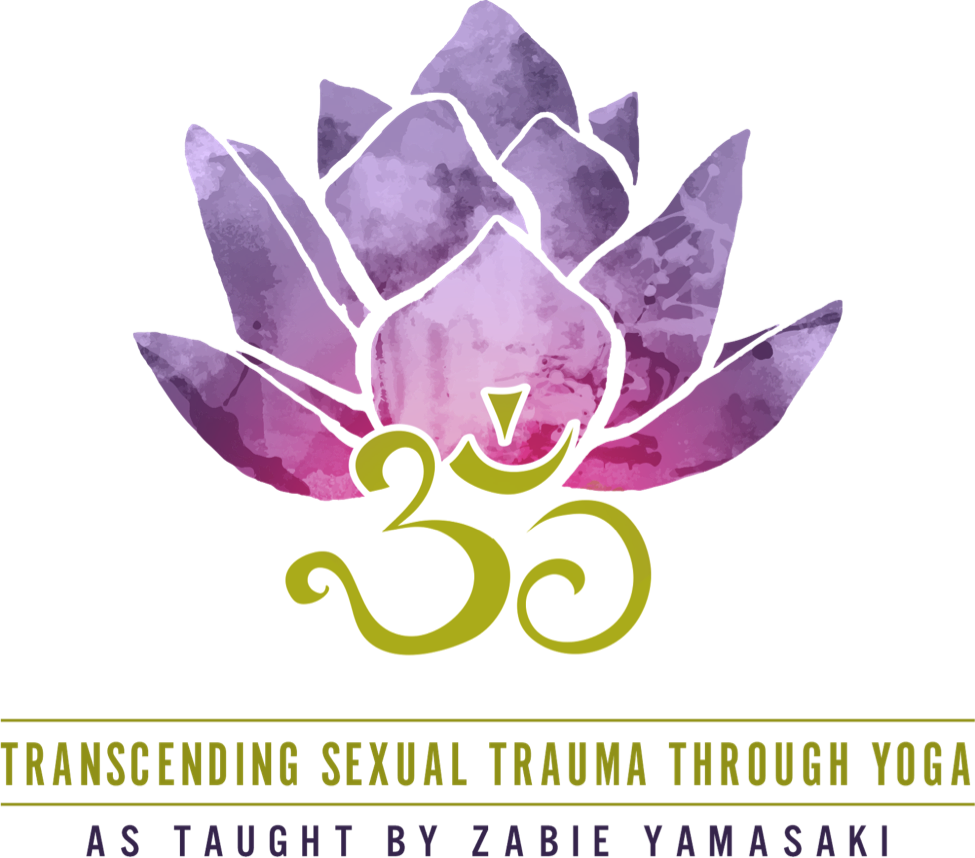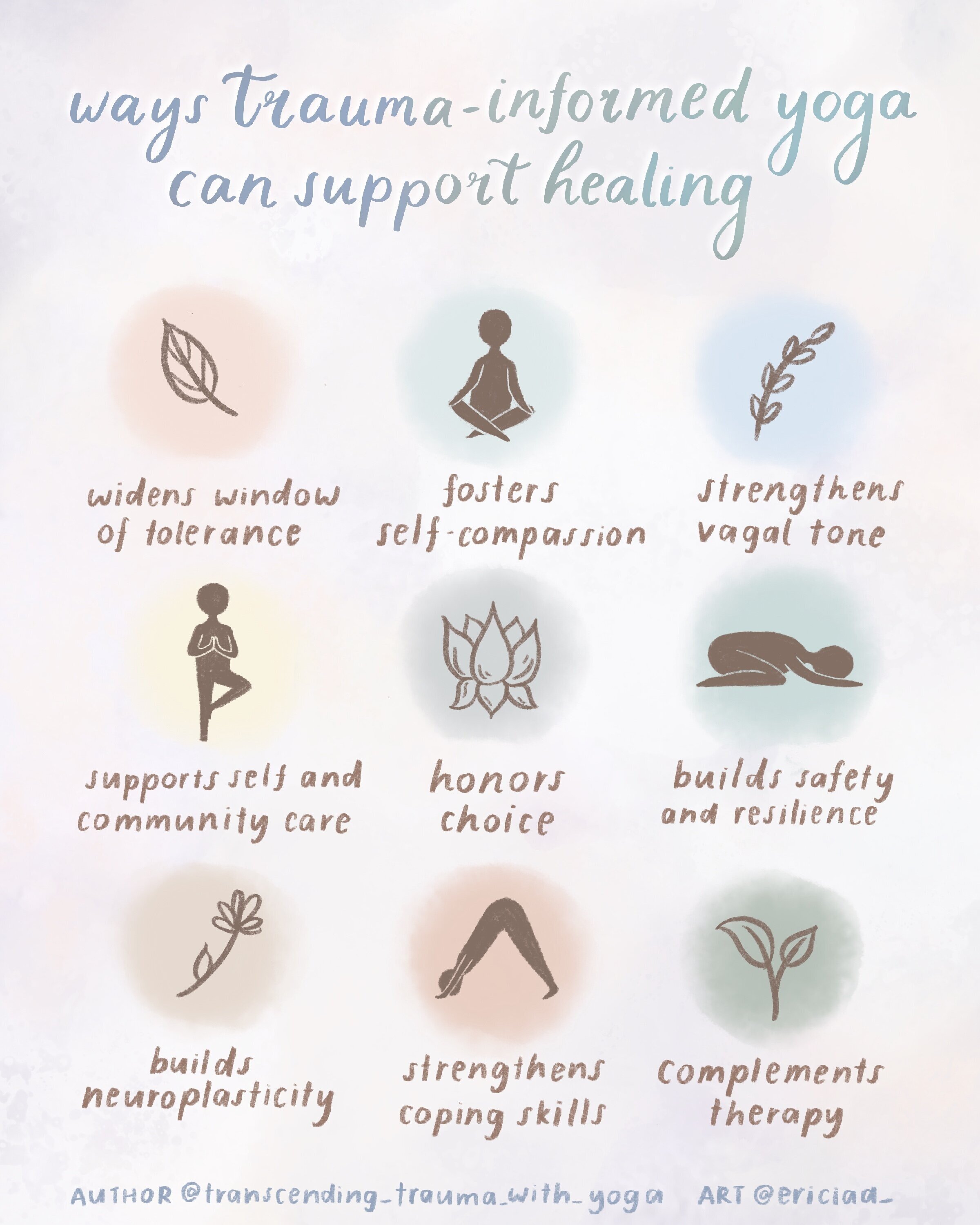Start Here
Learn More About Trauma Informed Yoga
with Zabie Yamasaki
NBC
Sexual Assault Survivors Find Healing
Power In Yoga
Healing thRough yoga
Transcending Sexual Trauma Through Yoga is an organization solely dedicated to empowering survivors of sexual violence to heal through the practice of yoga. Memories of sexually violent experiences can be intrusive, which can create challenges for survivors. These memories can also make it difficult for those looking to establish connection in their lives and learn how to trust again. The entire experience of practicing yoga can help survivors find union between seemingly disconnected and challenging aspects of the self, allowing participants to slowly build the pieces into an integrated whole.
Regardless of the nature of the traumatic incident, survivors may suffer from physical pain and emotional unrest after experiencing a trigger or as a chronic underpinning of their daily activities. There is no doubt that trauma impacts brain functioning. After experiencing trauma, the amygdala goes into over-drive and anticipates danger even when there is none. Trauma can leave the body feeling dis-regulated and unsafe, The practice of trauma-sensitive yoga can help survivors establish safety and resource their body in a way that feels authentic and manageable- truly unique to their needs.
a Mindful Method
This program provides a venue for survivors to become acquainted with and reclaim their bodies, helps them become grounded in the present moment, and allows them to explore the benefits of mindfulness as they flow breath to movement in guided trauma-informed practice and meditation. Classes are comprised of a 5-week series or 8-week series which focus on intentional weekly themes, encompass various chakras and restorative postures, and build strength in the core. Classes are also coupled with guided activities including de-briefing exercises, journaling, and art therapy. Classes will explore the deeper meaning behind strength and pain, and allow survivors to build community in a safe, supported, and peaceful environment.
holistic healing
This program specifically focuses on self-acceptance and provides survivors with tangible benefits that will become noticeable throughout their practice. This gradual integration can be transformational and healing for survivors. This program provides the opportunity for survivors to:
Find peace and healing through yoga practice
Exercise the choices they have to move their body in ways that feel comfortable
Learn to establish connection to self, trust others, and strengthen relationships
Establish safety and stability in the body
Tap into inner strength and build skills and positive coping mechanisms for managing painful experiences
Build a strong network and community
Regain power and control through mindful movements and reconnection to the body
Yoga provides a safe and accessible way for survivors to explore their healing internally and uncovers layers of pain to get to the core of who they have always been. It offers them a beautiful form of expression that moves beyond trying to find the words to articulate how they feel. These inward experiences of healing on the yoga mat can elicit positive outcomes and tangible skills that survivors may have been working on for years in cognitive therapy to achieve. Past participants have shared that they were empowered to report to the police what had happened to them because they felt strong and stable in their bodies, others were able to be intimate again with a partner because they felt they could assertively communicate their boundaries, and one participant in particular took complete control of her binge eating because she realized that she did not need to have control in an unhealthy way.
Survivors have also shared that the yoga as healing program increased their confidence and self-esteem, helped them learn how to trust themselves and others, allowed them to develop a strong sense of community, helped them incorporate self-care strategies, and empowered them to seek other resources.
services offered
Consultation for colleges/universities, rape crisis centers, and domestic violence shelters on the implementation of a comprehensive trauma-informed yoga as healing program for survivors
Trauma-informed Yoga Teacher Trainings (3-day)
Trauma-informed yoga trainings for Mental Health Professionals
Consultation and training for yoga studios on trauma-informed approaches
Includes trauma-informed training for yoga instructors in your 200-hour or 500-hour yoga teacher training curriculum)
Self-care, Vicarious Trauma, Compassion Fatigue workshops for staff
Private classes
Group classes (5 or 8 week series format and/or drop-in format)
Can be taught on-site at university or agency
Mentoring for yoga instructors interested in teaching trauma-informed yoga and building holistic healing programs
To print a brochure, click here.
Sliding scale and equity pricing is always available. Click here to learn more.
What is Trauma-Informed Yoga?
This graphic visualizes the impact that trauma-informed yoga programs have had on survivors of sexual violence through a series of programs at UC Irvine and CSP Rape Crisis Center. Many survivors gained tangible skills, positive coping mechanisms, and experiences of empowerment through participation in trauma-informed yoga that they had been working on for many years in talk therapy.
Nikki Myers who does incredible work with yoga and recovery says, “there is no hierarchy in healing.” This is a concept that has always anchored me in trauma-informed work. There is no one size fits all approach when it comes to trauma healing. I never want to assume that we are having uniform experiences. And while I will certainly share some broad considerations around trauma-informed care at its intersection with yoga, there is no checklist, shortcut, or yoga posture that could ever capture the complexity, nuance, and sensitivity of this work. Instead we do our very best to provide survivors with a menu of supportive options that are rooted in trauma-informed, anti-racism and anti-oppression frameworks, empower them to decide what feels best for their healing process, support them in honoring the beautiful choices they have with their own bodies, and practice humility in moments when we may cause harm and hold ourselves accountable towards repair.
Being trauma-informed is a philosophy and a systemic framework of the way we truly see people and honor their humanity. It is a lifelong commitment to leaning in and doing the work of being an ally, educating ourselves, being aware of our biases, and engaging in culturally affirming practices. It is commiting to and engaging in our work that at all costs: avoids retraumatization. It helps us to compassionately and empathetically hold a safe container. And it allows every interaction to be a powerful reminder: people are the experts of their own experience.
Frameworks that inform Transcending Sexual Trauma through Yoga Training:
Empowerment-based language
This language creates a choice-based environment where survivors are in control and choose to participate in ways that feel comfortable. It allows them the opportunity to be gentle with themselves. Examples of cues given in class include:
“As you’re ready”
“If you’d like”
“You can always modify to suit your experience”
“Please bring this exercise to an end whenever you feel ready”
“Feel free to come out of the posture at any time”
“I invite you to listen to your body”
“I Invite you to meet your body and breath wherever it is today”
“You are always in control of your practice”
“Everything is optional”
Sample statements:
•The choices you make with your body are always celebrated here.
•You are always in control of your practice.
•You are your greatest teacher.
•I invite you to send yourself gratitude just for arriving to your mat today. So often that is the hardest part.
•I invite you to take a moment to reflect on your journey and how far you’ve come. Inhale and exhale at your pace.
•There are many ways to communicate your comfort level with assists. I honor your choices and you can change your mind at any time.
•If being with the internal sensations feels too overwhelming, know that you can explore focusing on the exteroceptive sensations in the room. Perhaps a color, sound, scent- choose what feels soothing and supports you in re-orienting to the space.
Integration of choices
Choices are central to the practice of trauma-informed yoga. Words used in class to facilitate this environment include: notice, feel, explore, experiment, and maybe
Supportive Presence
Trauma-informed yoga instructors create a supportive and non-judgemental environment. Their presence in the room is safe, predictable, and consistent. They maintain healthy boundaries and support survivors in exploring what boundaries and assertiveness looks like through movement and reconnection to their own bodies.
Trauma-informed yoga instructors create an environment where survivors can engage in their practice in their own way and challenge themselves when they feel ready to do so.
Trauma-informed yoga instructors are genuine, caring, and authentic and create a space where survivors can come to the yoga mat and be exactly who they are.
The Art of Assisting
There are NO physical assists in trauma-informed yoga instruction.
The Trauma Center at the Justice Resource Institute considers physical assists to be a clinical issue and they do not recommend them.
Physical assists can be incredibly triggering for survivors and can take away from the present moment. Many survivors are not ready to be seen and prefer not to have the extra attention on them.
Trauma-informed practice is about teaching students about their own capacity to self-regulate. There are varying degrees of pain in the body and in the heart, and these classes respect the wide spectrum of survivor needs.
Lastly, often times survivors struggle with setting boundaries and asking for what they need. By providing only verbal instruction, trauma-informed yoga instructors empower survivors to find comfort in their own shape.
“We create spaces where freedom and personal embodiment are valued and cherished. We can create a deeper connection with students as we verbally assist them in the process of navigating and reclaiming their bodies. We give them freedom to explore their bodies exactly as they are.” - Alexis Marbach
Safety and Space
Survivors are invited to set up the yoga space in whatever way they feel comfortable. Not only do we help facilitate regaining power and control of the body but also of the immediate environment. Trauma-informed yoga instructors offer choices around lighting, room set-up, music, and props. Our organization strives to create empowering environments to give survivors permission to take care of themselves.
Invitation of Postures
Survivors are invited to notice the sensations in their own bodies and to exercise choices through the various postures and modifications provided. These experiences often times facilitate healing off of the yoga mat. Trauma often involves being physically held down or immobilized. Trauma-informed yoga practice always allows the survivor to be in control.
For example, one of the first statements made in class by a trauma-informed yoga instructor is, “Know that the hardest part is over, you made it to your mat. If you wanted to find one posture that you connect with and stay there for the entire time, that would be perfect.”
Breath and Trauma
Trauma-informed breath practices involve breathing in and out only in ways that feel safe and comfortable for the survivor. Often times breath can be linked to triggers associated with trauma including holding the breath, accelerated heart rate, constricted breathing, inability to breathe, shortness of breath, and suffocation. As a result, there are no constricted breathing cues in trauma-informed yoga classes.
There are many therapeutic benefits to breathwork including:
Increased awareness of breath patterns
Decreased anxiety and self-regulation
Energizing and calming
Reconnection
Grounding and presence
Sensitivity to Triggers
Trauma-informed yoga instructors are trained in supporting students through triggers as they arise and providing them with strategies and tools for self-regulation, processing, and coming back to the present moment.
Themes and Philosophy Integration
Classes are closely tied to Bija Bennett’s “Emotional Yoga” and incorporate themes very relevant to the needs of survivors including: safety, mindfulness, boundaries, assertiveness, strength, trust, and community.
Self-Care for the Teacher
Cultural Considerations and Accessibility
Sexual violence and anti-racism work have never been separate.
There are already many barriers preventing folks from marginalized populations, from practicing yoga include: financial accessibility, able-ism, sexism, homophobia, transphobia, and geographical availability.
Everyone deserves to feel safe, seen and included. Trainings will cover culturally affirming responses to support survivors.





